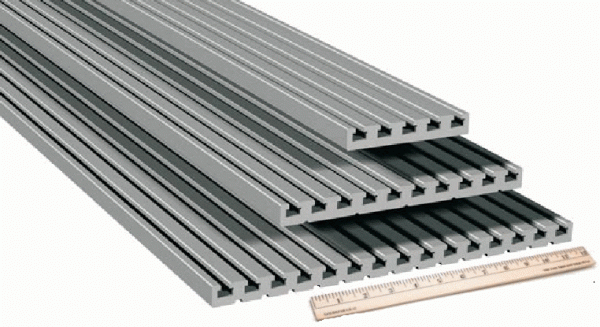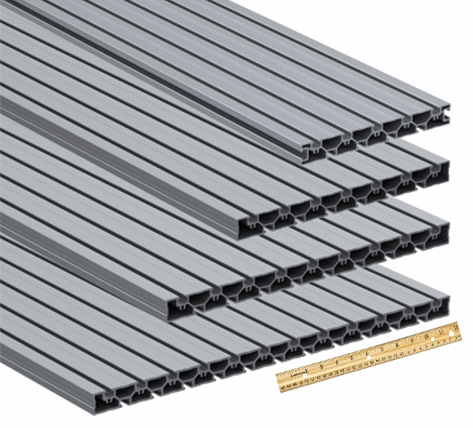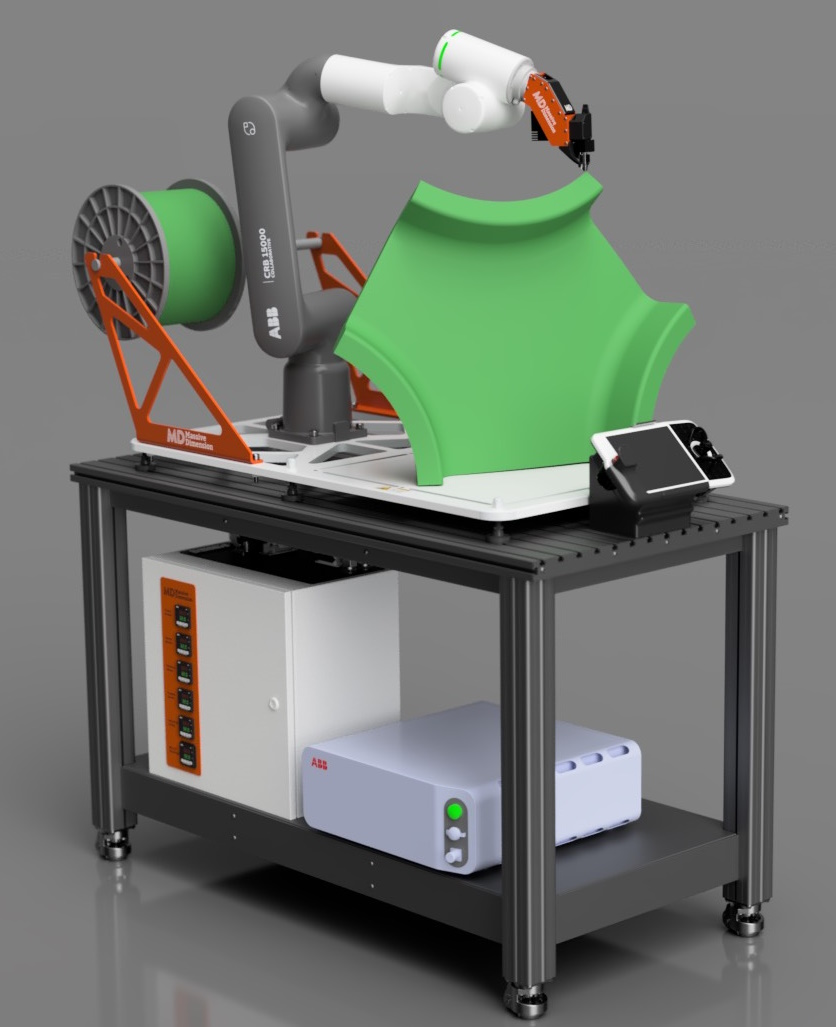Aluminum T Slot Table Plate Extrusions : What They Are and Where to Use Them
Aluminum T Slot Table Plate Extrusions : What They Are and Their Applications
Making aluminum extrusions is easy – send a contract to an extruder and send them the print and you get a truck full of extrusions. But be careful of the pitfalls! There are numerous problems and pitfalls that can arise, especially when dimensional accuracy and straightness are important.
One important limitation of extrusions is the “sharp corner” which cannot be done. You can achieve corners with small radii but not square corners.
Besides this limitation, extrusions are limited to the size of the available presses, commonly about 8”-12” in diameter. But the larger the ratio of width to thickness, the greater the possibility of twists and bends. These usually arise from uneven heating and cooling of both the incoming and outgoing aluminum. There are a number of techniques to minimize twist and bow but there is of course no ultimate solution. And even applying moderate remediation techniques can add significantly to the costs of producing the extrusion.
The uneven heating and cooling can also leave a surprise in the extrusion when it is machined. Machining of extrusions often results in stress relief which can deform or twist the extrusion after machining. Again there are approaches to stress relieving of extrusions but they are time consuming and expensive e.g. heating an extrusion to 300°C for 3 or 4 hours will relieve most of the stress in an extrusion profile.
At Isel, we have developed a number of techniques to produce aluminum extrusions that have minimal problems with twists or bows. These techniques have been applied to a variety of profiles, especially our T Slot table plate extrusions. Our table plate extrusions are families of T Slot extrusions, available in a variety of widths which are much wider than they are thick. These extrusions are offered in both machined and unmachined forms. The machined versions are extruded with a small amount of excess material on both the top and bottom of the profile and that excess material is machined off. This creates a profile that has the desired net shape as well as a top and bottom that are both parallel and straight to a higher tolerance than what is achievable by extruding alone. These table plates are available as both solid profiles as well as hollow profiles.
Solid profile table plates are ideal for applications involving heavy objects that can easily “ding” the surface. The solid profile is much more resistant to these handling dings. The hollow profiles have walls that are anywhere from 1-2 mm thick.
Let us digress for a moment to review beam deflections. For a simply supported beam or a cantilevered beam, the deflection of a beam is inversely proportional to the bending moment of inertia. The bending moment of inertia for a simple rectangular cross section goes as the 4th power of the thickness of the cross section. There are of course other factors such as internal configuration and weight of aluminum but the “thickness” is a good guideline – generally “thicker” means less deflection. Assuming the widths are similar and the weight / unit length is similar, the bending moment of inertia will be significantly larger for a “thicker” profile because of the 3rd power of the thickness. The deflection is generrally inversly proportional to the bending moment of inertio i.e the larger the bending moment the smaller the deflection.. This would be true for either a cantilevered load or a simply supported beam. This of course is useful in selecting which type of extrusion would be preferable for the application.
Armed with this information, what can these T Slot table plate extrusions be used for? The obvious and straightforward application is for fixture plates. We have a number of customers that build special application machines that offer simple fixturing by using our T Slot table plate extrusions as fixture plates for their customers using the specialized machines. Along the same lines, the T Slots offer flexibility and ease of reconfiguring the fixturing for custom applications, whether it is a secondary application like drilling or trimming or even a glue dispensing application.
Design Not Stiff Enough?
In many applications, relatively long distances might need to be spanned and in some cases the long beams might have to bear significant loads. Remember - ALUMINUM IS SOFT RELATIVE TO METALS LIKE STEEL and so you might encounter sag or deflection. But what to do about deflection or sag in aluminum structures? Isel hass developed a series of panel profiles ranging in widths from 50mm to 250mm. Recall that the deflection or stiffness is roughly proportional to the 4th power of the thickness i.e. the wider the profile is in the axis of interest, the less sag or deflection can be expected
We offer a number of standard and custom workbenches with the T Slot table plate tops. The workbenches offer an obvious advantage of flexibility over solid surface tops that require drilling and tapping at precise locations for customization and mistakes can be costly! With the T Slots, customers can layout their designs and adjust as the need arises by just loosening and retightening the screws and T nuts.
These T Slot topped workbenches are also finding applications as robot and cobot pedestal bases. The same features that make the workbenches ideal for flexible fixturing applications apply to the robot applications as well. The workbenches have the ability to combine a cobot pedestal along with load and unload stations. The T Slots make positioning easy and re-positioning easier than regular pedestals.
Structural T Slot extrusions revolutionized machine design and safety enclosure design applications. The T Slot table plate extrusions are now revolutionizing how designers are approaching problems of fixturing and robot and cobot pedestal base applications.
Making aluminum extrusions is easy – send a contract to an extruder and send them the print and you get a truck full of extrusions. But be careful of the pitfalls! There are numerous problems and pitfalls that can arise, especially when dimensional accuracy and straightness are important.
One important limitation of extrusions is the “sharp corner” which cannot be done. You can achieve corners with small radii but not square corners.
Besides this limitation, extrusions are limited to the size of the available presses, commonly about 8”-12” in diameter. But the larger the ratio of width to thickness, the greater the possibility of twists and bends. These usually arise from uneven heating and cooling of both the incoming and outgoing aluminum. There are a number of techniques to minimize twist and bow but there is of course no ultimate solution. And even applying moderate remediation techniques can add significantly to the costs of producing the extrusion.
The uneven heating and cooling can also leave a surprise in the extrusion when it is machined. Machining of extrusions often results in stress relief which can deform or twist the extrusion after machining. Again there are approaches to stress relieving of extrusions but they are time consuming and expensive e.g. heating an extrusion to 300°C for 3 or 4 hours will relieve most of the stress in an extrusion profile.
At Isel, we have developed a number of techniques to produce aluminum extrusions that have minimal problems with twists or bows. These techniques have been applied to a variety of profiles, especially our T Slot table plate extrusions. Our table plate extrusions are families of T Slot extrusions, available in a variety of widths which are much wider than they are thick. These extrusions are offered in both machined and unmachined forms. The machined versions are extruded with a small amount of excess material on both the top and bottom of the profile and that excess material is machined off. This creates a profile that has the desired net shape as well as a top and bottom that are both parallel and straight to a higher tolerance than what is achievable by extruding alone. These table plates are available as both solid profiles as well as hollow profiles.
 |
 |
| PT 25 Table Plate Extrusions - SOLID PROFILE |
PR 30 Table Plate Extrusions - HOLLOW PROFILE |
Solid profile table plates are ideal for applications involving heavy objects that can easily “ding” the surface. The solid profile is much more resistant to these handling dings. The hollow profiles have walls that are anywhere from 1-2 mm thick.
Let us digress for a moment to review beam deflections. For a simply supported beam or a cantilevered beam, the deflection of a beam is inversely proportional to the bending moment of inertia. The bending moment of inertia for a simple rectangular cross section goes as the 4th power of the thickness of the cross section. There are of course other factors such as internal configuration and weight of aluminum but the “thickness” is a good guideline – generally “thicker” means less deflection. Assuming the widths are similar and the weight / unit length is similar, the bending moment of inertia will be significantly larger for a “thicker” profile because of the 3rd power of the thickness. The deflection is generrally inversly proportional to the bending moment of inertio i.e the larger the bending moment the smaller the deflection.. This would be true for either a cantilevered load or a simply supported beam. This of course is useful in selecting which type of extrusion would be preferable for the application.
| I= bh3 12 |
Armed with this information, what can these T Slot table plate extrusions be used for? The obvious and straightforward application is for fixture plates. We have a number of customers that build special application machines that offer simple fixturing by using our T Slot table plate extrusions as fixture plates for their customers using the specialized machines. Along the same lines, the T Slots offer flexibility and ease of reconfiguring the fixturing for custom applications, whether it is a secondary application like drilling or trimming or even a glue dispensing application.
Design Not Stiff Enough?
In many applications, relatively long distances might need to be spanned and in some cases the long beams might have to bear significant loads. Remember - ALUMINUM IS SOFT RELATIVE TO METALS LIKE STEEL and so you might encounter sag or deflection. But what to do about deflection or sag in aluminum structures? Isel hass developed a series of panel profiles ranging in widths from 50mm to 250mm. Recall that the deflection or stiffness is roughly proportional to the 4th power of the thickness i.e. the wider the profile is in the axis of interest, the less sag or deflection can be expected
We offer a number of standard and custom workbenches with the T Slot table plate tops. The workbenches offer an obvious advantage of flexibility over solid surface tops that require drilling and tapping at precise locations for customization and mistakes can be costly! With the T Slots, customers can layout their designs and adjust as the need arises by just loosening and retightening the screws and T nuts.
 |
|
| FANUC CRX on AT3 Workbench Pedestal | MASSIVE DIMENSION Large Format 3D Printer with ABB Robot on AT2 Workbench Pedestal |
These T Slot topped workbenches are also finding applications as robot and cobot pedestal bases. The same features that make the workbenches ideal for flexible fixturing applications apply to the robot applications as well. The workbenches have the ability to combine a cobot pedestal along with load and unload stations. The T Slots make positioning easy and re-positioning easier than regular pedestals.
Structural T Slot extrusions revolutionized machine design and safety enclosure design applications. The T Slot table plate extrusions are now revolutionizing how designers are approaching problems of fixturing and robot and cobot pedestal base applications.


